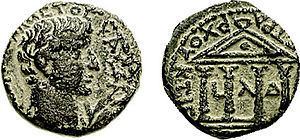Name Philip Tetrarch Siblings Herod Antipas | Parents Herod the Great Died 34 AD | |
 | ||
Grandparents Antipater the Idumaean, Cypros Similar People | ||
Philip the Tetrarch | Wikipedia audio article
Philip the Tetrarch, sometimes called Herod Philip II (Greek: Ἡρώδης Φίλιππος, Hērōdēs Philippos) by modern writers (ruled from 4 BC until his death in AD 34) was the son of Herod the Great and his fifth wife, Cleopatra of Jerusalem. Philip II was born in ~19 BCE. He was a half-brother of Herod Antipas and Herod Archelaus; and should not be confused with Herod II, whom some writers call Herod Philip I.
Contents
- Philip the Tetrarch Wikipedia audio article
- Background
- Marriage and dynasty
- Naming convention
- References
Background
Philip inherited the northeast part of his father's kingdom, which included Iturea and Trachonitis; and possibly Gaulanitis and Paneas, as was noted by Flavius Josephus.
Augustus Caesar made his own division of Herod's kingdom, giving one half to Archelaus, while dividing the other half into two, going to Antipas and Philip. Batanea, along with Trachonitis and Auranitis (with a certain part of what was called the House of Zenodorus), paid the annual tribute of one hundred talents to Philip.
Marriage and dynasty
Philip married his niece Salome, the daughter of Herodias and Herod II (sometimes called Herod Philip I, and also a member of the Herodian dynasty). This Salome appears in the Bible in connection with the execution of John the Baptist. However, there would have been a great difference in their ages: Salome was born in ~14 CE, at which time Herod Philip was 32 years old! The gospels of Matthew and Mark state that the Herodias whom Herod Antipas married was the wife of Antipas' brother "Philip", a fact supported by Josephus, who indicated she was the wife of Herod II (a.k.a. Philip I). It is known that Philip the Tetrarch rebuilt the city of Caesarea Philippi, calling it by his own name to distinguish it from the Caesarea on the sea-coast, which was the seat of the Roman government. It is possible that the 'Salome' he was married to was a half-sister by that same name, a daughter of Herod the Great and his 8th wife Elpis. This sibling Salome was born in ~14 BCE, and so only five years younger than Herod Philip (a more realistic age gap). But this would also be the only known occurrence of the children of Herod the Great intermarrying, even if from different mothers. Marriage to 1st cousins and uncles, however, was relatively common in the so-called Herodian dynasty.
Naming convention
There is no contemporary evidence for Philip the Tetrarch's use of the name "Herod Philip" as a dynastic title, as did occur with his brothers Herod Antipas and Herod Archelaus. Herod II is sometimes called "Herod Philip I" (because the gospels call the husband of Herodias "Philip"), and then Philip the Tetrarch is called "Herod Philip II". Kokkinos says, "The stubborn existence of many theologians in referring to Herod III as 'Herod Philip' is without any value...No illusory Herod Philip ever existed."[p 223-233]; [266] Philip the Tetrarch, "unlike his brothers, did not use Herod as a dynastic name." Philip's half-brothers, Archelaus and Antipas, had adopted the name of Herod, "presumably" for a dynastic claim from Herod the Great.
